p.105
p.111
p.118
p.123
p.129
p.134
p.141
p.148
p.159
Evaluation for RC Column Confined Partially with Externally FRP Wrapping Sheet Using Nonlinear FE Analysis
Abstract:
Little research has been carried out in validating, fiber reinforced polymer (FRP) concrete strengthened column and the effective using partial wrapping. Also the effect of several parameter on strengthen column using the partial wrapping sheet of desired width and thickness around column have not been found out. To this end, a nonlinear 3D finite element model has been developed in current study for CFRP strengthened reinforced concrete column to simulate the behavior accompanied by the effect of partial wrapping with emphasis on load capacity and failure mode. The finite element simulation of CFRP strengthened RC columns is performed using commercial finite element program ABAQUS. Modelling was conducted on reinforced concrete columns with dimensions of 160 x 250 x 960 mm. The finite element model incorporates the nonlinear material behavior of concrete, bilinear stress-strain curve of steel and linear elastic behavior of CFRP material. The concrete was modeled using a plastic damage model. The performance of the FE model was studied by simulating experimental columns from the literature. The load, and strain of CFRP obtained from the FE study were compared with the corresponding experimental results. The FEM results agreed well with the experiments. In addition, to enhance our understanding of the behavior of strengthened reinforced concrete column capacity using partial wrapping the effect of changing the spacing between the CFRP sheets and number of layers were examined. The increase number of layers and decrease spacing give a higher ultimate load capacity, and delay the failure.
Info:
Periodical:
Pages:
129-133
Citation:
Online since:
October 2019
Authors:
Keywords:
Price:
Сopyright:
© 2019 Trans Tech Publications Ltd. All Rights Reserved
Share:
Citation:


